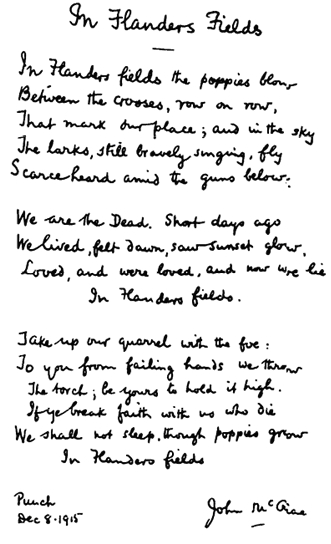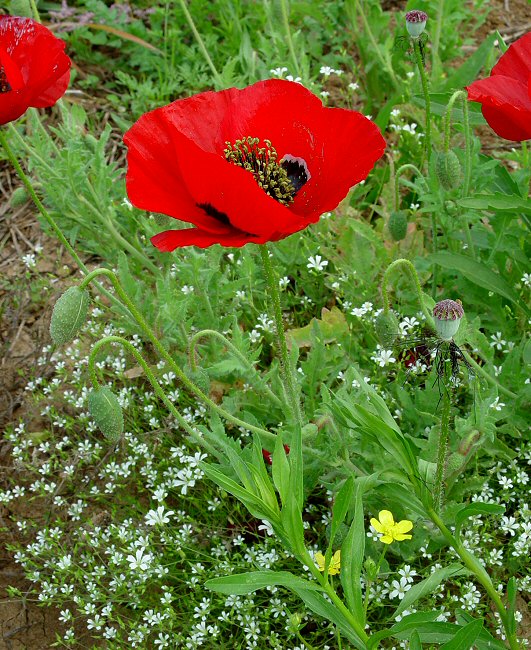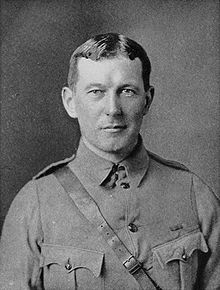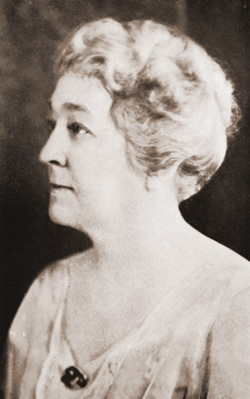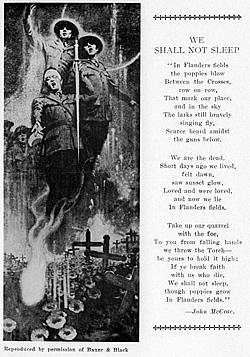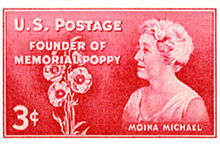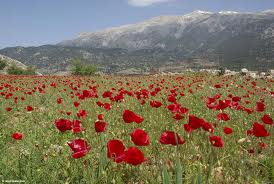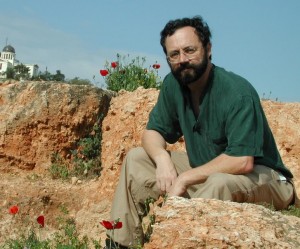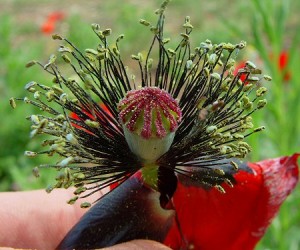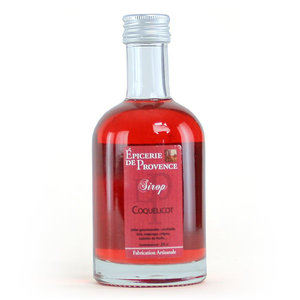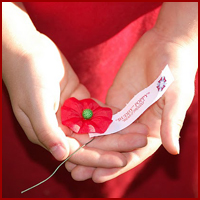(Yes, I am a veteran. Thus on this Memorial Day let us think of friends and relatives and everyone’s loved ones who did not come home alive. More than a century ago the Poppy became that reminder.)
Several plants have relatives whose reputations are difficult to live down. The Natal Plum is one. Related to the Oleander the delicious plum suffers from its deadly kin’s reputation. The Corn Poppy shares a similar fate. Mention poppies today and folks think opium. Mention poppies 90 years ago and people thought World War I. The Corn Poppy is the memorial flower of veterans. Silk and paper poppies are handed out for donations to veteran causes and worn on Memorial Day. The practice began with a poem.
Canadian John McCrae was a poet who was also a surgeon and medical officer on the front lines. Sitting in an ambulance on 3 May 1915, he wrote the poem “In Flanders Field” the day after personally conducting a burial service for a friend, Alexis Helmer. At the service McCrae mentioned the poppies. After writing the poem with a pencil stub he showed it to a couple of soldiers then reportedly tossed the poem away but it was recovered by those who read the first draft. After revisions and one rejection by The Spectator it was published 8 December 1915 in Punch Magazine. The poem begins with: In Flanders fields the poppies grow.* It became the most quoted poem of the era. In 1918 an American Young Womans’ Christian Association worker (and college teacher) Moina Belle Michael was attending a YWCA Overseas War Secretaries’ conference in New York City. She saw a copy of the Ladies Home Journal with the poem in it with its ascending illustration (below left.) Though she had read the poem many times she was struck by accompanying artwork. In her autobiography, ”The Miracle Flower, The Story of the Flanders Fields Memorial Poppy” written in 1941 on the eve of World War II, she wrote:
“I read the poem, which I had read many times previously, and studied its graphic picturization. The last verse transfixed me — ‘To you from failing hands we throw the Torch; be yours to hold it high. If ye break faith with us who die, we shall not sleep, though poppies grow in Flanders Fields’. This was for me a full spiritual experience. It seemed as though the silent voices again were vocal, whispering, in sighs of anxiety unto anguish, ‘To you from failing hands we throw the Torch; be yours to hold it high. If ye break faith with us who die we shall not sleep, though poppies grow in Flanders Fields’. Alone, again, in a high moment of white resolve I pledged to KEEP THE FAITH and always to wear a red poppy of Flanders Fields as a sign of remembrance and the emblem of ‘keeping the faith with all who died’. In hectic times as were those times, great emotional impacts may be obliterated by succeeding greater ones. So I felt impelled to make note of my pledge. I reached for a used yellow envelope, turned the blank side up and hastily scribbled my pledge to keep the faith with all who died.”
So moved Michael went out that afternoon and managed to find some artificial poppies and handed out 25 keeping one herself. The tradition was born. Later Michael wrote a poem herself, “We Shall Keep The Faith.” It had the verse: We cherish too, the poppy red, that grows on fields where valor led, It seems to signal to the skies, that blood of heroes never dies.”
In 1920 Anna E. Guerin, another YWCA secretary visiting from France, learned of the custom while attending an American Legion convention which was supporting the sale of poppies. Guerin decided when she returned home to hand-make the poppies and raise money to benefit orphans and widows of the war. It was she who sent a
delegation of French widows to visit British Field Marshal and former Commander-in-Chief Douglas Haig in 1921. They had poppies with them and suggested selling them to raise money for the injured and unemployed veterans. Haig, who by then was 1st Earl Haig, lent his support to the cause and himself set up the Haig Fund that still supports veterans. The practice was firmly established when several countries officially recognized the veterans’ poppy. To this day, paper poppies are assembled by needy and disabled veterans in hospitals and raise millions of dollars each year. But why the Corn Poppy? To answer that you have to know somethings about the species.
Poppies thrive on disturbed ground and can tolerate high amounts of lime. The plant also produces millions of seeds. The seeds can lie dormant in the ground for years until disturbed. The shelling and the trenching of the war brought them out of slumber. More so they grew where nothing else would grow, the lime-rich blasted ground of no man’s land and make-shift graves. The bright red poppies reaching out of blood-soaked ground made a lasting impression upon the generation.
For a plant with such a notorious relative the Corn Poppy has many uses. Young leaves are cooked and used like spinach, or raw as flavoring in soups and salads. The petals are used to make a red syrup used in soups or for coloring. The seeds can be used in cakes, bread, rolls, or pressed for their oil which is an excellent substitute for olive oil. Who as a child (or older) played with the poppy seeds falling off a roll? The rosette of basal leaves before the plant flowers is excellent raw as well. The unripe ovaries are also edible raw.
Like its genus mates the corn poppy has a white sap but no particular hallucinogenic qualities. It got the name “corn poppy” from a time when all agricultural grains — oats, wheat et cetera — were generally called corn. The flower grew in the disturbed ground of “corn” fields. As for the botanical name Papaver (Pap-PAY-ver) is Dead Latin for milk, in reference to its sap. Rhoeas (ROH-ee-as) is Latin bastardized Greek for red, referring to the color of the blossom. Poppy is an Old English variation of Papaver. Other common names include Flanders Poppy, California Red Poppy, and Shirley Poppy.
Green Deane’s Itemized Plant Profile: Corn Poppy
IDENTIFICATION: Papaver rhoesa: Stems from a large tap root, white to yellow sap, many stems, branching, green with some purple at the base; leaves alternating, lower leaves with stems, upper leaves without stems, serrated teeth, small hairs with glandular base; Flowers have four to six petals, scarlet with a black splotch (can be white) 1.5 to 3 inches wide, many stamens exceeding the pistil, anthers yellow grown.
TIME OF YEAR: May to October
ENVIRONMENT: Waste ground or disturbed ground, neither hot weather or cold weather.
METHOD OF PREPARATION: Young leaves cooked, or raw in salads; petals edible, seeds edible.
* The original poem said “where poppies blow” but it was changed to where poppies grow with both words being used. The debate on how the first line should end continues. Here is the first published version:
